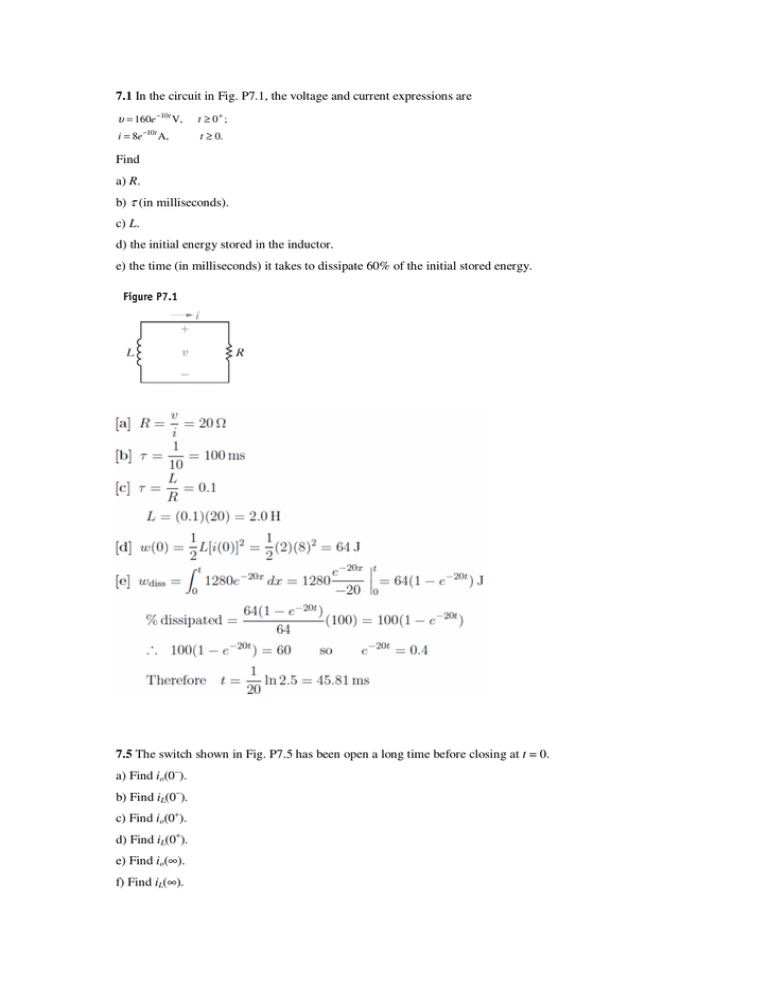RL & RC Circuit Analysis: Exam Problems
advertisement

7.1 In the circuit in Fig. P7.1, the voltage and current expressions are υ = 160e −10t V, t ≥ 0+ ; −10t t ≥ 0. i = 8e A, Find a) R. b) τ (in milliseconds). c) L. d) the initial energy stored in the inductor. e) the time (in milliseconds) it takes to dissipate 60% of the initial stored energy. 7.5 The switch shown in Fig. P7.5 has been open a long time before closing at t = 0. a) Find io(0−). b) Find iL(0−). c) Find io(0+). d) Find iL(0+). e) Find io(∞). f) Find iL(∞). g) Write the expression for iL(t) for t ≥ 0. h) Find υL(0−). i) Find υL(0+). j) Find υL(∞). k) Write the expression for υL(t) for t ≥ 0+. l) Write the expression for io(t) for t ≥ 0+. 7.10 In the circuit shown in Fig. P7.10, the switch has been in position a for a long time. At t = 0, it moves instantaneously from a to b. a) Find io(t) for t ≥ 0. b) What is the total energy delivered to the 8 Ω resistor? c) How many time constants does it take to deliver 95% of the energy found in (b)? 7.21 In the circuit in Fig. P7.21 the voltage and current expressions are υ = 72e −500t V, i = 8e −500 t mA, t ≥ 0; t ≥ 0 +. Find a) R. b) C. c) τ (in milliseconds). d) the initial energy stored in the capacitor. e) how many microseconds it takes to dissipate 68% of the initial energy stored in the capacitor. 7.23 The switch in the circuit in Fig. P7.23 has been in position a for a long time and υ2 = 0 V. At t = 0 the switch is thrown to position b. Calculate a) i, υ1 and υ2 for t ≥ 0+. b) the energy stored in the capacitor at t = 0. c) the energy trapped in the circuit and the total energy dissipated in the 5 kΩ resistor if the switch remains in position b indefinitely. 7.31 At the time the switch is closed in the circuit in Fig. P7.31, the voltage across the paralleled capacitors is 50 V and the voltage on the 250 nF capacitor is 40 V. a) What percentage of the initial energy stored in the three capacitors is dissipated in the 24 kΩ resistor? b) Repeat (a) for the 400 Ω and 16 kΩ resistors. c) What percentage of the initial energy is trapped in the capacitors? 7.41 The switch in the circuit in Fig. P7.41 has been open a long time before closing at t = 0. Find υo(t) for t ≥ 0+. 7.52 The switch in the circuit seen in Fig. P7.52 has been in position a for a long time. At t = 0, the switch moves instantaneously to position b. For t ≥ 0+, find a) υo(t). b) io(t). c) υg(t). d) υg(0+). 7.66 There is no energy stored in the circuit in Fig. P7.66 at the time the switch is closed. a) Find i(t) for t ≥ 0. b) Find υ1(t) for t ≥ 0+. c) Find υ2(t) for t ≥ 0. d) Do your answers make sense in terms of known circuit behavior? P7.68 at the time the switch is closed. a) Find io(t) for t ≥ 0. b) Find υo(t) for t ≥ 0+. c) Find i1(t) for t ≥ 0. d) Find i2(t) for t ≥ 0. e) Do your answers make sense in terms of known circuit behavior?



